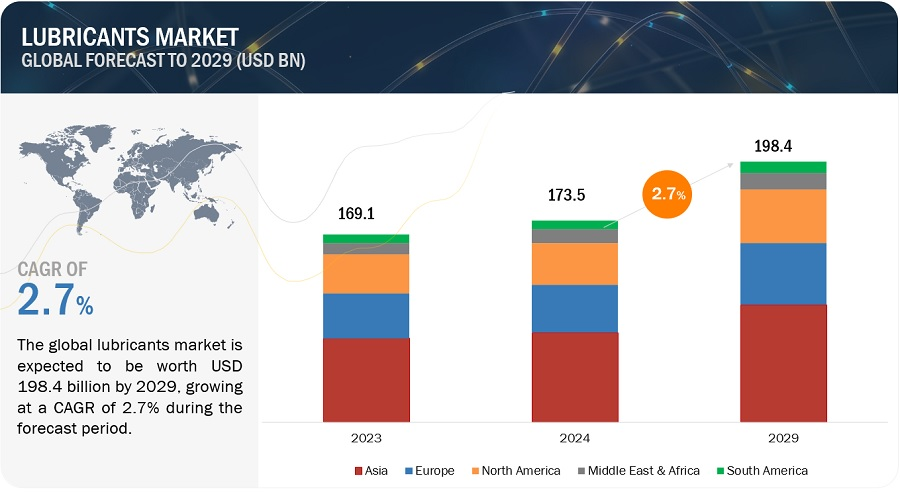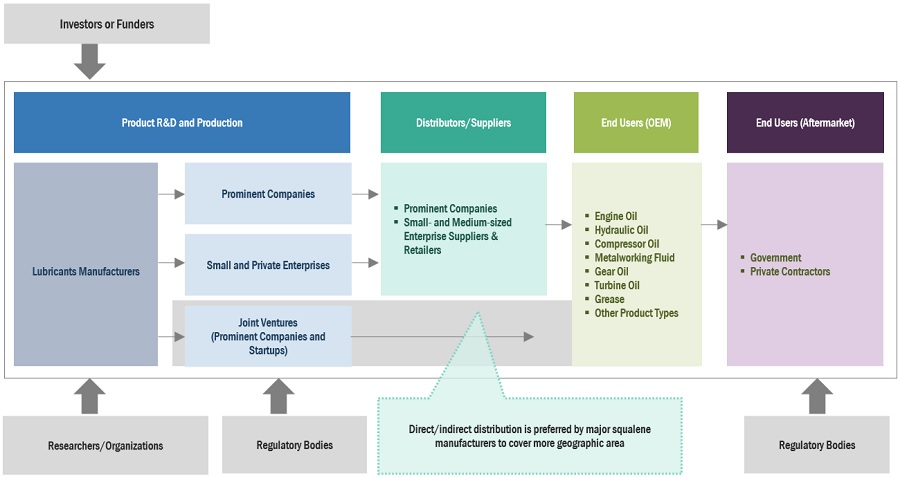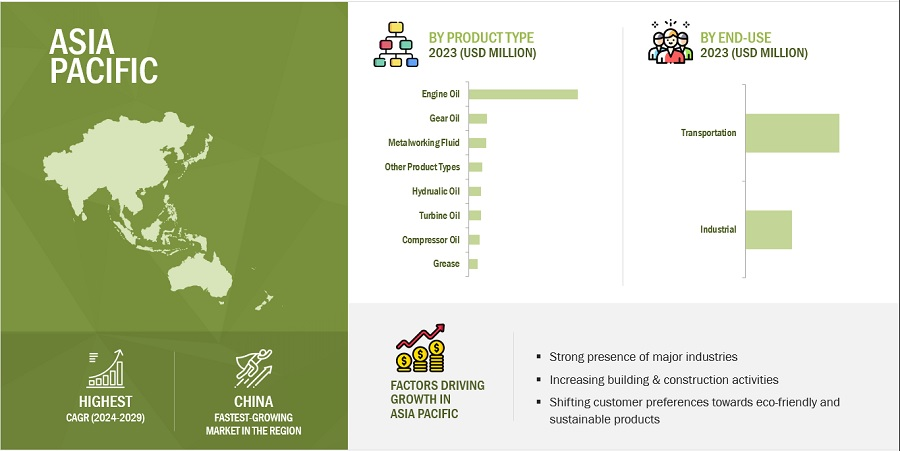Lubricants Market - Global Forecast to 2029
In terms of value, the lubricants market is estimated to grow from USD 173.5 billion in 2024 to USD 198.4 billion by 2029, at a CAGR of 2.7%. One of the major reasons for making a positive outlook for the lubricants market is the mounting demand for high performance engines, growing demand from marine application and limitations of electric vehicles. Also, technological advancements in the lubricants are pushing the market. Due to these reasons, the consumption of lubricants has grown significantly.
Market Dynamics
Driver: mounting demand from marine applications across worldwide
The global demand for marine applications is boosting the lubricants market due to several factors. Increased seaborne trade is driving shipping volumes and fleet sizes, leading to higher demand for marine lubricants. Stricter environmental regulations are pushing ship operators towards eco-friendly lubricants. Marine lubricants also enhance fuel efficiency and reduce operational costs, meeting stringent regulations from the International Maritime Organization. The growing tourism sector, especially for cruise ships, is favoring demand for marine lubricants. Additionally, ongoing research and technological advancements in lubricant formulations are meeting the evolving needs of the marine industry. Overall, the rising demand for marine applications worldwide is driving the lubricants market forward, emphasizing environmental sustainability, fuel efficiency, cost-effectiveness, tourism sector growth, and technological innovation.
Restraints: growing demand of electric vehicles
The rise of electric vehicles is impacting the lubricants market in several ways. With lower maintenance requirements and extended oil change intervals, there's reduced demand for traditional lubricants. This trend is expected to slow down market volume growth. Additionally, lubricant manufacturers face challenges in adapting to this shift, needing to innovate and develop specialized products for electric vehicles to remain competitive. Overall, the increasing popularity of electric vehicles is reshaping the lubricants market landscape.
Opportunities: Growing demand from construction, mining, and agriculture industries
The booming mining, construction, and agriculture sectors are propelling growth in the lubricants market through increased equipment utilization and a focus on performance and efficiency. These industries heavily rely on machinery such as heavy-duty trucks, excavators, bulldozers, tractors, and harvesters, necessitating high-quality lubricants to ensure smooth operation and longevity. With modern machinery designed for optimal performance under harsh conditions, there is a growing demand for specialty lubricants capable of meeting these stringent requirements. Moreover, the geographic expansion of construction and mining activities, particularly in regions like Asia Pacific and the Middle East, further drives the demand for lubricants as more machinery is put to use. This industrial growth creates opportunities for the lubricants market to thrive by catering to the ongoing need for efficient machinery operation and maintenance.
Challenges: Strict environmental norms
Strict environmental regulations present a significant hurdle for the lubricants market. To comply with these regulations, manufacturers must develop products that are eco-friendly, emit fewer pollutants, and degrade naturally. Additionally, the industry faces pressure to transition towards renewable energy sources and bio-based lubricants to align with sustainability goals. This shift poses challenges but also opens up opportunities for growth. Moreover, the rise of cleaner technologies like hybrid and electric systems threatens the demand for traditional lubricants, potentially impacting market dynamics. Overall, navigating environmental regulations requires innovation and adaptation, presenting both challenges and opportunities for the lubricants industry.
Based on base oil type, synthetic lubricants is projected to register highest CAGR in lubricants market, in terms of value, during forecast period.Synthetic lubricants is projected to be the fastest growing base oil type, in terms of value of the lubricants market, due to shifting consumer preferences towards eco-friendly and sustainable products, and rising population. With a growing awareness of the health and environmental benefits of synthetic lubricants, consumers are increasingly seeking products free from synthetic chemicals. This demand is further bolstered by stringent government regulations aimed at promoting safety and transparency regarding synthetic lubricants. Consequently, manufacturers are adapting to these changing dynamics by investing in research and development of natural alternatives, driving innovation and expansion in the synthetic lubricatns market.
Based on product type, hydraulic oil was the fourth-largest segment of lubricants market, in terms of value, in 2023.Hydraulic oil holds the position as the fourth-largest product type in the lubricants market due to its widespread usage across diverse industries. It serves a vital role in hydraulic systems found in industrial and transportation sectors. Hydraulic oil facilitates efficient power transmission, lubricates moving parts, and ensures the smooth operation of hydraulic machinery. The increasing adoption of hydraulic equipment in heavy machinery and vehicles significantly drives the demand for hydraulic oil. Moreover, as hydraulic technology advances, the need for high-performance hydraulic oils continues to grow to maintain optimal performance and extend equipment lifespan. Thus, the versatility and essential function of hydraulic oil contribute to its prominence in the lubricants market.
Asia Pacific was the largest and projected to be the fastest-growing region, in terms of value, during the forecast period in the lubricants market.Asia Pacific was the largest and projected to be fastest-growing region in the lubricants market, in terms of value, during forecast period due to several factors. Increased industrialization and urbanization, particularly in countries like China and India, are impelling demand across end-use industries such as automotive, manufacturing, agriculture and construction. Rising incomes and expanding vehicle ownership rates are further driving lubricant demand in the automotive industry. Moreover, ongoing investments in transportation and infrastructure are expected to fuel significant growth in lubricant consumption in the region. In summary, the Asia Pacific's dynamic economic growth and industrial expansion position it as a key driver of growth in the lubricants market.
- Previous : Necessity and precautions of oil injection, hot oil circulation and sealing test of main transformer
- Next : Liquid-Immersed Transformers Market size to record USD 10.74 billion growth from 2023-2027, Increasing popularity of bio-based and naphthenic transformer oil is one of the key market trends







